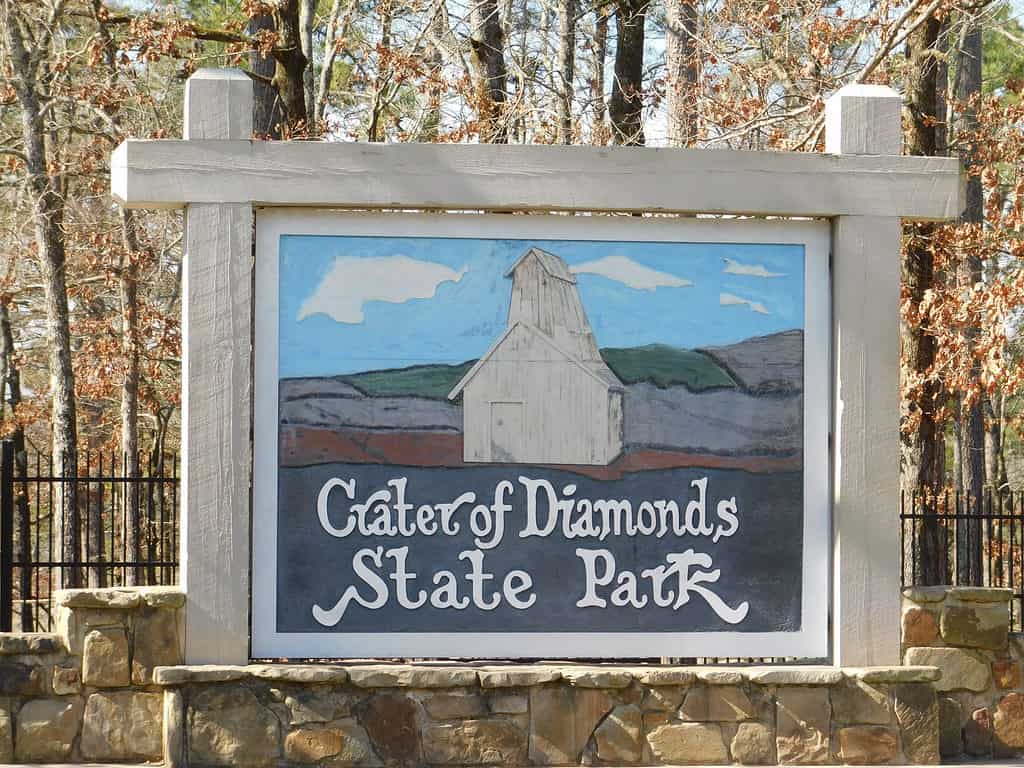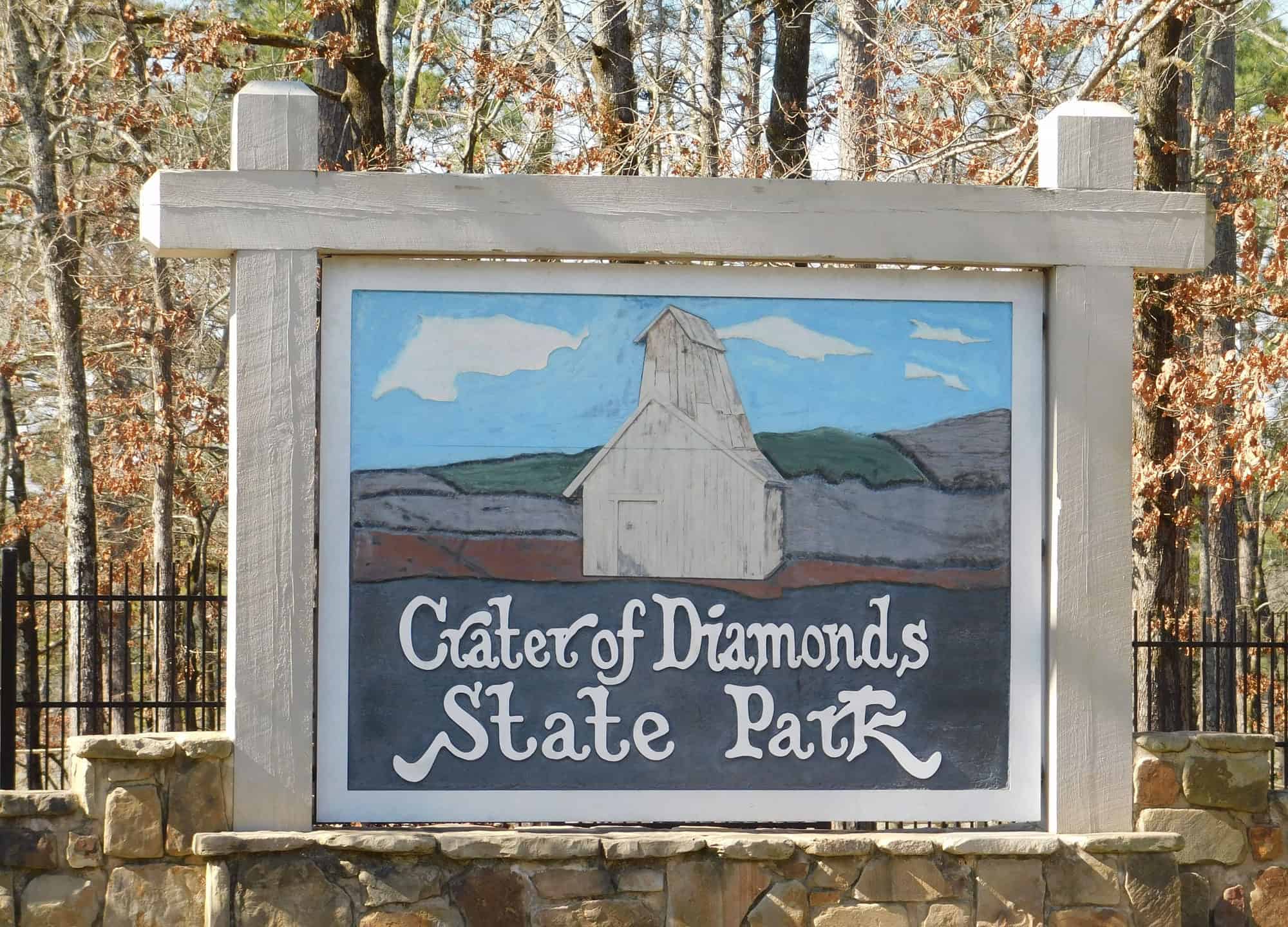Imagine mining for diamonds. You don’t have to leave this to your imagination, though. Plenty of unique places in the United States allow visitors to mine and look for diamonds and gems. One of these special places is Crater of Diamonds State Park in Arkansas. This article will dive into this gorgeous state park, including its history, the best time to visit, and your odds of finding a diamond.
About Crater of Diamonds State Park

With nearly 40 acres total of gemstones, visitors flock to the Crater of Diamonds State Park.
©Lloyd Weema/Shutterstock.com
Crater of Diamonds State Park is in Pike County, Arkansas. The surface area for this exciting state park is 911 acres. The state park’s history began in 1906. During this year, John Huddleston purchased a farm for his family. Within the same year, Huddleston, a farmer, found two crystals. Those two crystals were just the beginning. Huddleston wasted no time and sold the land for $36,000. It changed owners a lot.
Uncle Sam is one of the most notable diamonds ever found in this area. Uncle Sam is the largest diamond ever discovered in the United States. Wesley Oley Basham found this originally 40.23-carat diamond in 1924. You can now see it in the Smithsonian Museum of Natural History. It’s alongside the Canary Diamond, also found on the same site.
Best Time To Visit
The best time to visit this start park is during fall and spring. Although the park is open year-round, the weather isn’t always ideal. There isn’t much shade in or around the field where visitors can mine for diamonds. Summers in Arkansas can be sweltering! The average maximum temperature in Arkansas is around 91°F in July. If you visit during summer, don’t forget to wear sunscreen and a hat to protect your head. Winters aren’t too cold, but they can be wet. Some people recommend visiting during winter after a rainstorm, as the rain may uncover diamonds and make it easier to sift through.
How To Get There
Getting to Crater of Diamonds State Park is relatively easy. The nearest airport is nearly 45 miles away, Texarkana (TXK) Airport. The Hot Springs Airport (HOT) is a similar distance away. It’s recommended to drive to Crater of Diamonds State Park. The most accessible point of reference to this state park is Murfreesboro, Arkansas.
Murfreesboro is a city with a population of less than 2,000. The town is in southern Arkansas, with a surface area of 3.71 square miles. You can either stay in Murfreesboro or camp within the state park. The park features 47 Class AAA campsites. You can also find two modern bathhouses with hot showers in the campground. You can check camping availability online.
Cost
Although inexpensive, entry into this unique state park isn’t free. Visitors must pay $13.00 per person for those over 12 years old to enter. For children between the ages of 6 and 12, the price is $6.00. Children 6 and under can join for free. While in the state park, you may also pay for rental equipment or bring your own. The rental equipment’s prices vary.
For instance, it costs $5.00 to rent a small box screen. A $20.00 deposit is required for this item. The deposit is refundable and varies depending on the rental. Folding army shovels, 3.5-gallon buckets, kneeling pads, and long-handle shovels are all $5.00 to rent. The screen sets and Saruca, though, are $7.00. Wagons, on the other hand, are $15.00. You can rent the basic diamond hunting kit, including an army shovel, screen set, and 3.5-gallon bucket, if you want the basics, for $15.00. For $5 extra, you can upgrade to the Advanced Diamond Hunting Kit with a Saruca.
Activities
Diamond hunting might be the main attraction of this state park, but it isn’t the only thing to do. Listed below are other activities you can enjoy when taking a break from diamond hunting. Under the diamond hunting section, you’ll find notable finds and diamond hunting tips and tricks.
Hiking
Other than diamond hunting, hiking is one way to pass the time and enjoy the park. There are several trails to take. One popular trail is the Little Missouri River Trail. It’s an excellent day hike and is 1.2 miles long, taking roughly an hour to complete. This easy trail takes hikers to the scenic Little Missouri River through the woods.
Another hiking trail within the state park is the 1.2-mile Prospector Trail. It takes less than an hour to complete and is perfect for families.
Last but not least is the Wildlife Observation Blind Trail. It’s the shortest trail offered in the state park, running for 0.2 miles.
Diamond Discovery Center
The best way to learn more about the park and diamonds is to visit the Diamond Discovery Center. This center features many engaging and interpretive exhibits. You can rent equipment here, ask questions, and view the Diamond Hunters’ Hall of Fame.
Diamond Hunting

You can mine for diamonds while visiting the Crater of Diamonds State Park.
©Doug Wertman from Rogers, AR, USA, CC BY 2.0 – Original / License
Most people visit Crater of Diamonds State Park for diamond hunting. It’s a special place and one of the only diamond-producing sites in the world where the public can search for natural diamonds. Generally, whatever diamond or minerals you find, you keep! Also at the Crater of Diamonds State Park are garnet, jasper, agate, quartz, and amethyst.
The diamonds at this site are at an ancient diamond-bearing volcanic crater. So, what do diamonds look like? Not all diamonds look the same, but the ones typically found in the state park are smooth and well-rounded. They are small, about the size of a paper match head. A one-carat diamond is only about the size of a pea! Not all diamonds are white, either! They are translucent white, yellow, or brown. If you find a diamond or think you have, you can get it checked out at the Diamond Discovery Center. If you’re lucky and have found one, you can weigh and certify it for free.
Recent finds are posted on the website. Diamonds are nearly found daily and range in size. There are 100 points in a carat. One of the largest diamonds found in the park in November of 2023 weighed 48 points and was a white diamond.
Diamond Springs Water Park
If you don’t want to hike or it’s too hot to mine for diamonds, you can also beat the heat at the Diamond Springs Water Park. This water park is a small but fun, mining-themed aquatic playground. The aquatic playground features a 4,166-square-foot wading pool with two water slides, animated waterspouts, cascades, waterfall hideaways, water jets, and sprayers. The marine playground is open from 11 am to 5 pm from Memorial Day to Labor Day. The water park is closed on Mondays and Tuesdays.
Wildlife

Arkansas is home to over 400 species of birds. One of these species is the eastern kingbird.
©iStock.com/Emily Jackson Photography
Not many people visit Crater of Diamonds State Park to view wildlife. However, this doesn’t mean plenty of wildlife viewing opportunities exist. The easy and calm hiking trails offer opportunities to spot birds and native Arkansas plants. While visiting this state park, you may see mammals like Virginia opossums, eastern cottontails, red foxes, Eastern chipmunks, and American minks. You’re more likely, though, to feast your eyes on birds. In Arkansas, there are over 400 bird species. Most, though, are migratory. Some birds in Crater of Diamonds State Park include northern bobwhites, eastern kingbirds, blue jays, red-shouldered hawks, American goldfinches, and lark sparrows.
Thank you for reading! Have some feedback for us? Contact the AZ Animals editorial team.








